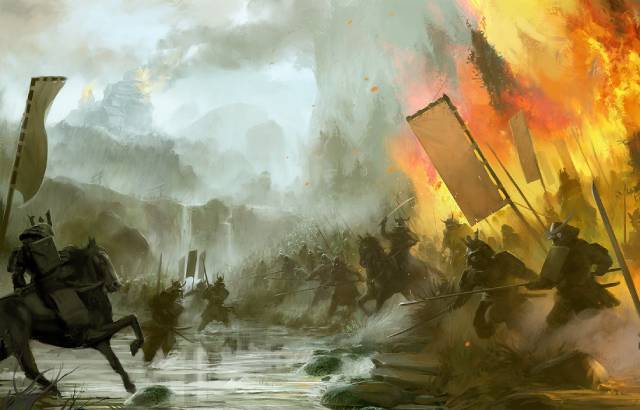
The Battle of Tenmokuzan in 1582 is remembered as the final stand of the Takeda clan in Japan. This battle marked the last attempt by Takeda Katsuyori to resist Oda Nobunaga's relentless campaign against him. Fleeing from his pursuers, Katsuyori set fire to his fortress at Shinpu Castle and sought refuge in the mountains at Iwadono, a stronghold held by his loyal retainer, Oyamada Nobushige. However, Oyamada betrayed Katsuyori, denying him entry. Left with no other option, Katsuyori committed suicide alongside his wife, while the remnants of his army made a valiant effort to hold off their attackers.
The conflict between the Takeda clan and Oda Nobunaga began in 1572 with the Battle of Mikatagahara, where Takeda Shingen, Katsuyori’s father and lord of Kai, Shinano, and Suruga provinces, defeated the combined forces of Nobunaga and Tokugawa Ieyasu in Totomi Province. However, the Takeda's fortunes changed drastically after Shingen’s death, as Katsuyori suffered a devastating defeat at the Battle of Nagashino in 1575, losing over 10,000 men, including many of his key generals. Despite this setback, Katsuyori managed to hold on to his family’s domains for several more years, thanks to Nobunaga's preoccupations with other conflicts, particularly against the Ikko-Ikki.
By February 1582, the situation became dire as several Takeda retainers in Shinano Province defected to Nobunaga. In response, Nobunaga's son, Oda Nobutada, launched an invasion of Shinano from the west, with Takeda garrisons either defecting or surrendering without resistance. The only significant engagement was the siege of Takato Castle, which fell on March 2, 1582. Meanwhile, Tokugawa Ieyasu invaded Suruga Province, which surrendered on February 25 due to the defection of key Takeda retainers.
After the fall of Takato Castle, the remaining Takeda forces in Shinano crumbled, and Nobutada's army pressed into the Takeda heartland of Kai Province. Simultaneously, Hojo Ujimasa advanced from the east, while Tokugawa Ieyasu entered Kai from the south, accompanied by Takeda traitor Anayama Genba. Katsuyori, realizing the hopelessness of his situation, fled Shinpu Castle on March 3 with a small retinue of 500-600 samurai and over 200 women and children. He sought refuge with Oyamada Nobushige at Kogakko Castle, but was turned away.
With no allies and no stronghold left, Katsuyori's remaining followers dispersed, leaving him with only 41 warriors and 50 women, all close family members, who made their final stand in a makeshift fort at Tano village. On March 11, Oda forces led by Takikawa Sakon discovered their camp and launched an attack. The Takeda warriors, realizing their fate, executed their families and fought fiercely to the death, embodying the samurai spirit in their final moments. Despite their bravery, they were overwhelmed, and Katsuyori, along with his son and loyal followers, perished.
The Shinchō Kōki, a chronicle of Nobunaga's life, praised the valor of the last Takeda samurai, noting particularly the heroism of Katsuyori's young companion, Tsuchiya Uemon, and his 16-year-old son, Takeda Nobukatsu. Even though Oyamada Nobushige had betrayed Katsuyori, he met his own end when he was executed by Nobunaga's officer, Horio Yoshiharu, after surrendering to the Oda forces. The Battle of Tenmokuzan remains a poignant symbol of the Takeda clan's tragic end and the unwavering samurai spirit displayed by Katsuyori and his men in the face of inevitable defeat.
See also
-
The Siege of Hara Castle

The Shimabara Rebellion of 1637–1638, which culminated in the siege of Hara Castle, was the last major uprising of the Edo period and had serious political consequences.
-
Battle of Tennoji

The confrontation between Tokugawa Ieyasu and Toyotomi Hideyori during the “Osaka Winter Campaign” ended with the signing of a peace treaty. On January 22, 1615, the day after the treaty was signed, Ieyasu pretended to disband his army. In reality, this meant that the Shimazu forces withdrew to the nearest port. On the same day, almost the entire Tokugawa army began filling in the outer moat.
-
Siege of Shuri Castle

The Ryukyu Kingdom was established in 1429 on Okinawa, the largest island of the Ryukyu (Nansei) archipelago, as a result of the military unification of three rival kingdoms. In the following years, the state's control spread to all the islands of the archipelago.
-
The Siege of Fushimi Castle
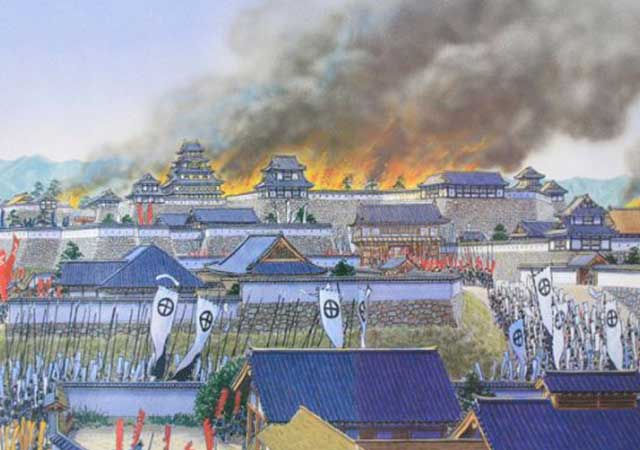
Fushimi can perhaps be considered one of the most “unfortunate” castles of the Sengoku Jidai period. The original castle was built by Toyotomi Hideyoshi in the southeast of Kyoto in 1594 as his residence in the imperial city.
-
The Siege of Otsu Castle
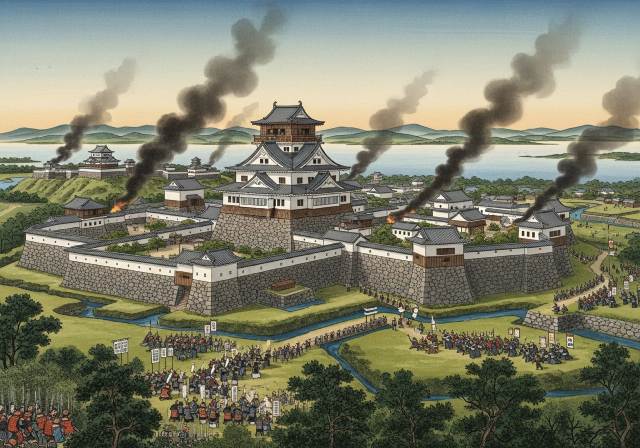
The siege of Otsu Castle was part of the Sekigahara campaign, during which the so-called Eastern Coalition, led by Tokugawa Ieyasu, fought against the Western Coalition, led by Ishida Mitsunari. Otsu Castle was built in 1586 by order of Toyotomi Hideyoshi near the capital Kyoto, on the site of the dismantled Sakamoto Castle. It belonged to the type of “water castles” — mizujō — as one side of it faced Japan's largest lake, Lake Biwa, and it was surrounded by a system of moats filled with lake water, which made the fortress resemble an island.
-
The Siege of Shiroishi Castle
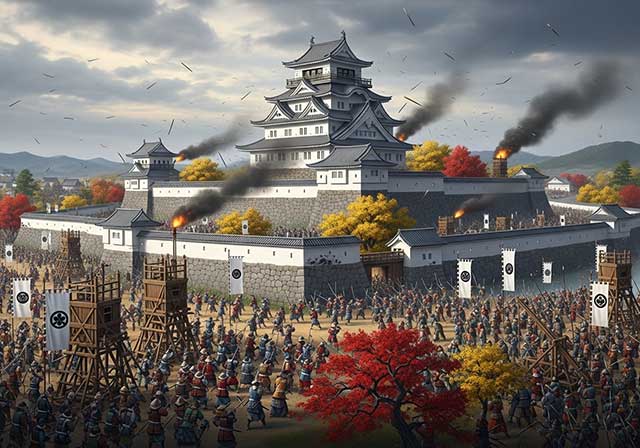
The siege of Shiroishi Castle was part of the Sekigahara campaign and took place several months before the decisive battle of Sekigahara. The daimyo of Aizu Province, Uesugi Kagekatsu, posed a serious threat to Tokugawa Ieyasu's plans to defeat the Western Coalition, and Ieyasu decided to curb his actions with the help of his northern vassals. To this end, he ordered Date Masamune to invade the province of Aizu and capture Shiroishi Castle.
-
The Second Siege of Jinju Castle
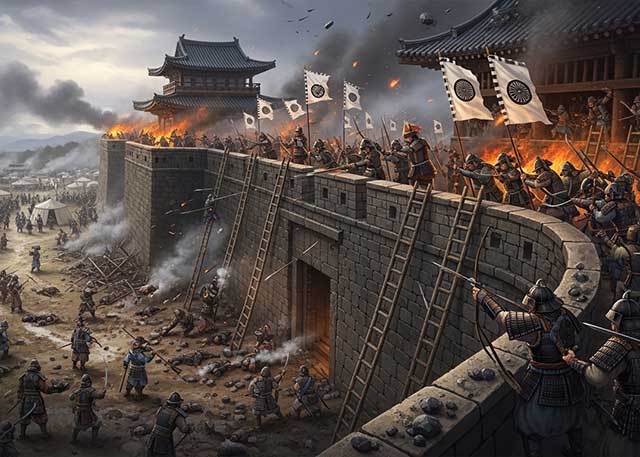
During the two Korean campaigns of the 16th century, the Japanese repeatedly had to capture enemy fortresses and defend occupied or constructed fortifications from the combined Korean and Chinese forces. Among all the operations of that time, the second siege of Jinju Castle is considered the most interesting from the point of view of siege warfare.
-
The Siege of Takamatsu Castle
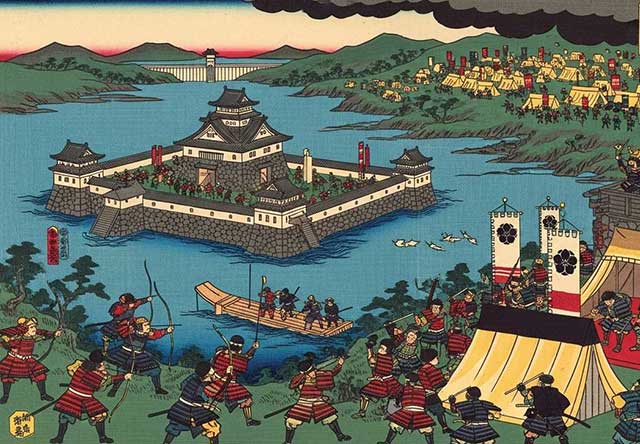
The siege of Takamatsu Castle in Bitchu Province is considered the first mizuzeme, or “water siege,” in Japanese history. Until then, such an original tactic had never been used.

